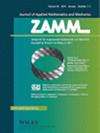倾斜拉伸表面上化学反应性生物对流卡森纳米流体流动的非相似分析
IF 3.2
4区 工程技术
Q1 MATHEMATICS, APPLIED
Zamm-zeitschrift Fur Angewandte Mathematik Und Mechanik
Pub Date : 2023-09-18
DOI:10.1002/zamm.202300128
引用次数: 0
摘要
非牛顿纳米流体中的生物对流在生物技术、生物力学、微生物学、计算生物学、医学等领域有着广泛的应用。考虑卡森流体模型和倾斜拉伸几何,建立了非牛顿纳米流体中化学反应对自行微生物生物对流特性影响的数学模型。可以溶解在血液(基础液)中的纳米颗粒包括氧化钛()和氧化铝()。还考虑了热产生、磁场和黏度耗散的影响。为了简化偏微分方程的控制系统,采用了边界层假设。通过适当的变换,将控制偏微分方程和与之相对应的边界条件进一步转化为无量纲形式。利用局部非相似技术,直到第二度截断,结合MATLAB的(bvp4c)内置有限差分代码,收集改变模型的结果。此外,在计算结果和已发表的结果之间取得良好的一致性之后,在图形配置中显示和检查了变化因素对流体流动和预期流动问题的传热特征的影响。设计了表格来建立阻力系数和努塞尔数的数值变量。本研究的结果是强调化学反应在卡森纳米流体生物对流中的重要作用,以及如何操纵化学反应参数可以影响流体的传递和传热/传质性质。研究发现,增加化学反应参数会导致生物对流卡森纳米流体的浓度曲线下降。提高卡森流体参数可以提高速度和温度分布。当Peclet数改变时,微生物的繁殖受到限制。此外,观察到随着生物对流刘易斯数的增加,活动微生物的密度也随之增加。由于孔隙率参数和洛伦兹力的放大作用,倾斜拉伸表面的摩擦系数显著增加。本文章由计算机程序翻译,如有差异,请以英文原文为准。
Non‐similar analysis of chemically reactive bioconvective Casson nanofluid flow over an inclined stretching surface
Abstract Bioconvection in non‐Newtonian nanofluids has a wide range of contemporary applications in biotech, biomechanics, microbiology, computational biology, medical science, etc. Considering the Casson fluid model and inclined stretching geometry a mathematical model is developed to investigate the influence of chemical reactions on bioconvection characteristics of self‐propelled microbes in a non‐Newtonian nanofluid. Nanoparticles that can be dissolved in the blood (base fluid) include titanium oxide () and aluminium oxide (). The impacts of heat generation, magnetic field, and dissipation of viscosity are also included. To simplify the governing system of partial differential equations (PDEs), boundary layer assumptions are used. By using the proper transformations, the governing PDEs and the boundary conditions that correspond with them are further changed to a dimensionless form. Utilizing a local non‐similarity technique up to the second degree of truncation in conjunction with MATLAB's (bvp4c) built‐in finite difference code, the results of the altered model are gathered. Additionally, after achieving good alignment between calculated findings and published results, the influence of changing factors on the flow of fluids and heat transfer features of the envisioned flow problems is shown and examined in graphical configuration. Tables are designed to establish numerical variants of the drag coefficient and Nusselt number. The Outcome of this study is to highlight the important role that chemical reactions play in the bioconvection of Casson nanofluids, and how manipulating the chemical reaction parameter can impact the transport and heat/mass transfer properties of the fluid. It is noted that increasing the chemical reaction parameter leads to a fall in the concentration profile of the bioconvection Casson nanofluid. Enhancing the Casson fluid parameter enhances the velocity and temperature profile. When the Peclet number is altered, the propagation of microorganisms is constrained. Moreover, it was observed that the density of motile microorganisms increased as the bioconvective Lewis numbers became higher. The coefficient of friction on the inclined stretched surface is increased significantly by the porosity parameter and Lorentz forces, as they act as amplifiers.
求助全文
通过发布文献求助,成功后即可免费获取论文全文。
去求助
来源期刊
CiteScore
3.30
自引率
8.70%
发文量
199
审稿时长
3.0 months
期刊介绍:
ZAMM is one of the oldest journals in the field of applied mathematics and mechanics and is read by scientists all over the world. The aim and scope of ZAMM is the publication of new results and review articles and information on applied mathematics (mainly numerical mathematics and various applications of analysis, in particular numerical aspects of differential and integral equations), on the entire field of theoretical and applied mechanics (solid mechanics, fluid mechanics, thermodynamics). ZAMM is also open to essential contributions on mathematics in industrial applications.

 求助内容:
求助内容: 应助结果提醒方式:
应助结果提醒方式:


